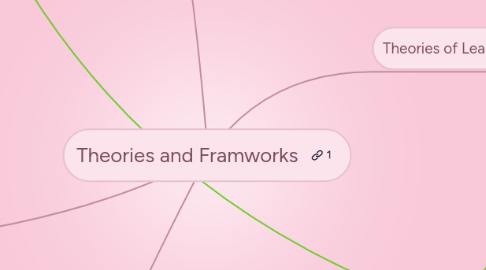
1. Theories of Technology
1.1. SCOT
1.1.1. Basics
1.1.1.1. Technology does not determine human action, but that rather, human action shapes technology.
1.1.2. Implications for Education
1.1.2.1. Teachers should help students decide which technological tools are practical for different types of assignments
1.2. Media Ecology
1.2.1. Basics
1.2.1.1. The study of media as environments.Media includes technology, symbol systems, codes, symbolic form, art, etc. Media Ecology is the idea that the media plays a leading role in human affairs.
1.2.2. Implications for Education
1.2.2.1. Since media influences society and affects the way people view the world students need to learn how to assess the credibility of various media sources so they learn to be critical thinkers of information they are exposed to. Teachers can play a role in teaching their students how to critically assess the credibility of various medias.
2. Philosophy of Technology
2.1. A teacher's personal beliefs and attitudes about the use of technology in the classroom and how he/she will use technology in his/her teaching
2.2. A teacher can write a philosophy of technology that expresses his/her ideas of the purpose, functionality, benefits, disadvantages, practicalities or any other thoughts he/she has about the importance and use of technology in a classroom
2.3. My philosophy of technology would probably have a connection to both constructivism and connectivism
3. TPACK
3.1. Framework three kinds of knowledge that teachers need to successfully integrate technology into the classroom
3.1.1. Content Knowledge
3.1.2. Pedagogical Knowledge
3.1.3. Technological Knowledge
3.2. This framework does not view the knowledge in isolation, it acknowledges that there is overlap between content knowledge, pedagogical knowledge and technological knowledge. The overlap creates additional types of knowledge. A Venn Diagram is used to represent the interactions between the different types of knowledge. http://randysresources.wikispaces.com/TPACK
3.2.1. Pedagogical Content Knowledge (PCK)
3.2.2. Technological Content Knowledge (TCK)
3.2.3. Technological Pedagogical Knowledge (TPK)
3.2.4. Technological Pedagogical Content Knowledge (TPACK)
4. Theories of Learning
4.1. Behaviourism
4.1.1. Basics
4.1.1.1. Ivan Pavolv- Classical Conditioning- learning a behavior can result from making associations between environmental stimuli and natural simuli
4.1.1.2. B.F Skinner-Operant Conditioning-effect of punishment and reinforcement on behavior. Learning is a function of change in behavior; change in behavior is the response of an individual's response to stimuli.
4.1.1.3. Focuses on observable behavior
4.1.1.4. Environment determines behavior
4.1.2. Implications for Education
4.1.2.1. Behavioral Modification- token economies- used to help children learn new skills and overcome poor behavior
4.1.2.2. Knowledge is a matter of remembering information
4.1.2.3. Passive learning- students must learn the correct response and results from external reward
4.1.2.4. Understanding is a matter of seeing existing patterns
4.1.2.5. Application in the classroom has been referred to as direct instruction (teacher-centered). Direct instruction has shown results particularly for children with learning problems.
4.1.2.5.1. Techniques for Direct Instruction
4.2. Cognitive Load
4.2.1. Basics
4.2.1.1. An information processing theory used to explain the limits of working memory based on current knowledge of human cognitive architecture
4.2.1.2. Involves working memory and long term memory
4.2.1.2.1. Working memory has a limited and finite capacity and learning requires maximum use of our limited working memory- working memory uses visual and auditory information.
4.2.1.2.2. Long term memory is virtually unlimited and assists working memory
4.2.2. Implications for Education
4.2.2.1. Strategies to help avoid cognitively overloading students
4.2.2.1.1. Knowledge Compression (chunking): chunking information with help it be presented as more meaningful and imitate schema development or activate existing schemas
4.2.2.1.2. Repetition: procedures need to be isolated and rehearsed many times
4.2.2.1.3. Avoid splitting attention by using clear presentation of information.
4.3. Constructivism
4.3.1. Basics
4.3.1.1. Learning is constructed. Learners build new knowledge upon the foundation of previous knowledge and prior knowledge influences new knowledge.
4.3.1.2. Learning is active. The teacher and students work collaboratively to solve real world problems. The students reflect on their learning.
4.3.1.3. Emphasizes authentic and challenging projects for students to help them develop metacognitive awareness to monitor and direct their own learning
4.3.1.4. Emphasizes knowledge construction not reproduction, conversation not reception, articulation not repetition, collaboration not competition, reflection not prescription.
4.3.2. Implications for Education
4.3.2.1. Understand student's preexisting knowledge and guide them to build on it at their level
4.3.2.2. Teach students to assess themselves and their strategies
4.3.2.3. Provide problem solving and inquiry based learning activities
4.4. Connectivism
4.4.1. Basics
4.4.1.1. A learning theory for the digital age
4.4.1.2. Learning occurs as a part of a network of many diverse connections and ties. Networks are made possible with various tools of technology
4.4.1.3. Thinking and emotions influence each other
4.4.2. Implication for Education
4.4.2.1. Empower students to take control of their learning and make connections with others who will strengthen the learning process
4.4.2.2. Include technology and connection making as learning activities
4.4.2.3. Teach students how to make personal learning networks and how to assess sources credibility; such as, blogs, websites, readers,audio podcasts, video podcasts, email, video conference, social bookmarking, voice threads, etc.
4.4.2.4. Teach students about information management
4.4.2.5. Teach students how to build networks and take advantage of opportunites
4.4.2.6. Provide guidance
4.4.2.7. Teach students how to communicate and respectfully ask for help from experts
4.4.2.8. Teachers should show their students how to differentiate between good information and propoganda
